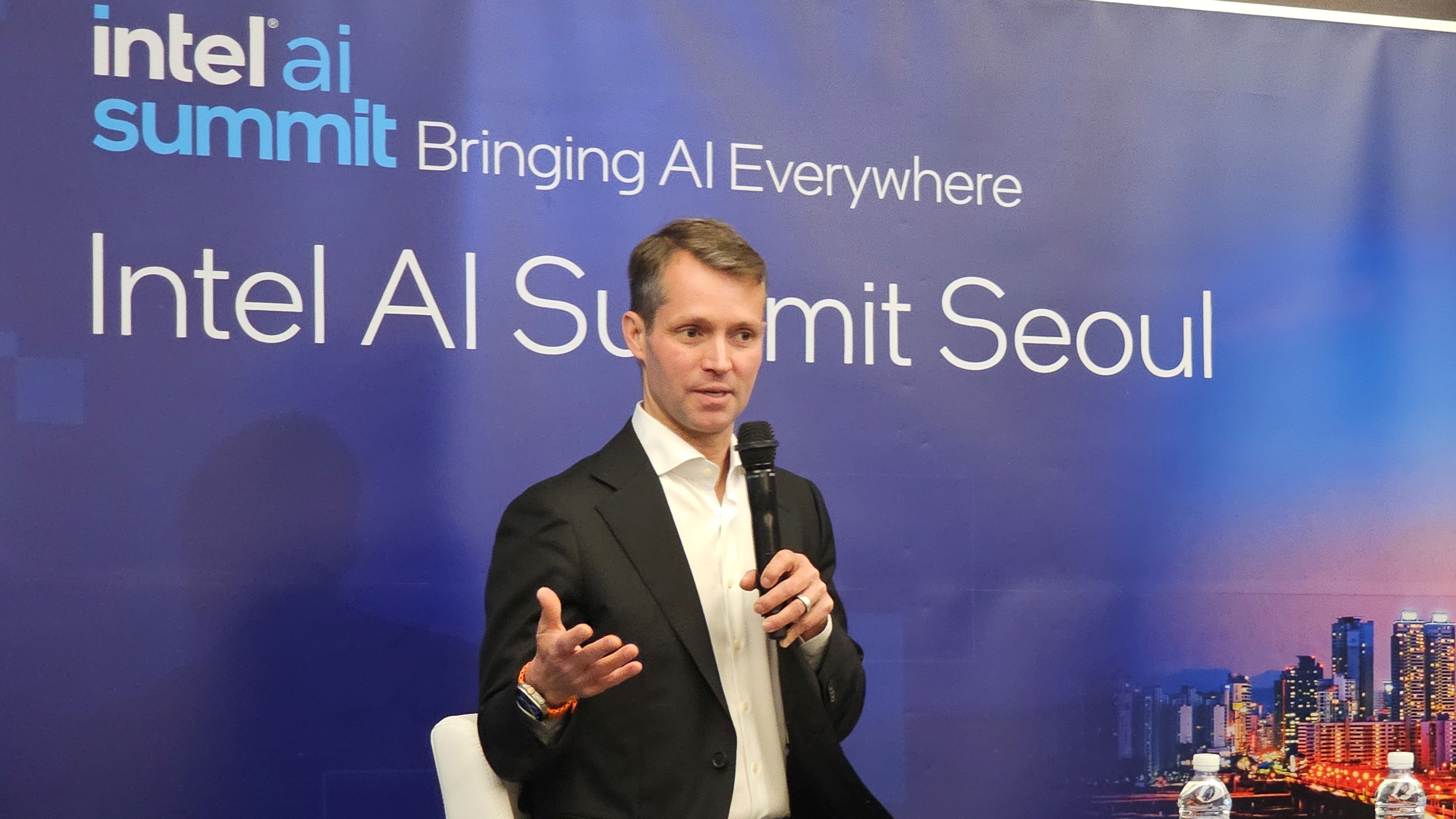“AI는 강력한 개방형 생태계가 필요하다. 네이버와의 전략적 파트너십도 같은 비전을 가지고 목표한 바를 이루고자 하는 것이다”
인텔 저스틴 호타드(Justin Hotard) 수석 부사장이 지난 5일 인텔 AI 서밋(Intel AI Summit)에서 AI에 대한 개방형 생태계 구축을 강조하며 인텔 중심의 AI 파트너십 확대 의지를 공고히 했다.

▲인텔 AI 서밋에서 기자회견 질의에 답변하고 있는 저스틴 호타드(Justin Hotard) 수석 부사장 겸 데이터센터 및 AI 그룹 총괄
인텔 중심 AI 오픈 생태계 강조
네이버, “AI칩 독과점 챌린지”
인텔-네이버AI 연합전선 강조
6G 통신 AI 생태계 장기 포석
“AI는 강력한 개방형 생태계가 필요하다. 네이버와의 전략적 파트너십도 같은 비전을 가지고 목표한 바를 이루고자 하는 것이다”
인텔 저스틴 호타드(Justin Hotard) 수석 부사장이 지난 5일 인텔 AI 서밋(Intel AI Summit)에서 AI에 대한 개방형 생태계 구축을 강조하며 인텔 중심의 AI 파트너십 확대 의지를 공고히 했다.
인텔이 5일 서울 서초구 JW 메리어트 호텔에서 ‘인텔 AI 서밋(Intel AI Summit)’을 개최했다. 인텔의 AI 시장 전망과 AI 관련 솔루션 및 진행 상황을 설명하는 자리로 국내외 주요 인텔 파트너 500여개사가 참가했다.
이번 인텔 AI 서밋에는 올해 2월 선임된 저스틴 호타드(Justin Hotard) 수석 부사장 겸 데이터센터 및 AI 그룹 총괄이 기조연설을 발표했다.
그는 “2026년까지 80%의 기업이 생성형 AI를 사용할 것으로 예상된다”면서 “생성형 AI에 대한 기업의 지출은 2027년까지 4배 증가할 것으로 전망한다”고 말했다.
인텔의 AI 에브리웨어 전략은 PC에서 데이터센터에 이르기까지, 또한 하드웨어에서 소프트웨어, 시스템을 아우르는 확장 가능한 AI 솔루션을 제공한다는 데 방점이 찍힌다.
이 접근 방식의 핵심을 호타드 부사장은 △애플리케이션 생태계 △소프트웨어 생태계 △인프라 생태계 △컴퓨팅 생태계로 손꼽는다. 엣지에서 데이터센터에 이르는 전 라인 개방형 생태계 구축에 인텔은 힘을 쏟고 있다.
이를 증명하듯 이번 인텔 AI 서밋에는 500여개 파트너사들이 참여해 세션을 경청했다. 네이버 하정우 소장이 호타드 부사장에 이어 2번째 키노트 세션을 발표하면서 “현재 생성 AI 시대 가장 큰 챌린지는 특정 AI 칩 중심으로 독과점되고 있다”면서 “공급이 수요보다 충분하지 않아 공급 우선순위에 따른 AI 격차 문제 발생할 수 있다”고 지적했다.
이것이 네이버가 인텔과의 AI 전략적 파트너십을 맺고 개방형 생태계를 지향하는 이유이다. 엔비디아의 최신 AI 칩셋에 대한 공급 병목이 발생하고 있으며 이에 개화되고 있는 AI 시장을 적기에 확보하려면 우회전략이 필요한 것이다.
인텔-네이버는 코랩을 구축해 카이스트 등 국내 대학 및 연구소와 협업해 가우디2 AI 가속기를 통해 LLM 구축을 연구·실험·평가하는 작업을 진행 중에 있다. 이를 통해 연말까지 vLLM에 대한 연구결과를 오픈소스화해 공개할 예정이다.
더불어 연말에 출시될 HBM2e가 탑재된 차세대 인텔 AI 가속기 가우디3에서도 동일하게 기존 LLM의 소스코드들이 연계될 수 있도록 하겠다고 덧붙였다.
인텔은 미래 AI 시장에서 인텔의 AI 솔루션 채택을 높이기 위해 생태계적 접근 방식을 취하고 있다. 이는 통신기술에 대한 전략적 협업에서도 장기적 포석이 드러난다. 호타드 부사장은 “6G 기술에서 SKT와 협력하고 있다”면서 “6G는 AI 애플리케이션 확산과 도입에 중요한 기술”이라며 이외에도 삼성, LG 등과 함께 AI PC 시대를 열어가는 것에 기대를 갖고 있다고 말했다.
또한 가우디3에서 최신 HBM 제품이 아닌 HBM2e를 선택한 이유에서도 호타드 부사장은 균형의 중요성을 강조했다. 그는 “여러 활용사례 가운데 성능과 효율성의 균형이 중요하다”며 “네트워킹, 컴퓨팅, 메모리 등에서 균형을 가져야 하며 가우디3는 GPU가 아닌 TPU이기에 엔터프라이즈 활용에서는 추론 영역이 중요하며 트레이닝 시간은 H100 대비 50% 개선됐다”고 강조했다.
